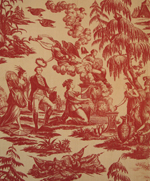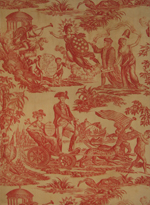|
Section I Selections from the C.W. McAlpin Collection
Section I Selections from the C. W. McAlpin CollectionSection VIEarly Textile Printing in Britain In the early 17th century Britain began to import hand-painted cottons from India. The advantage of these fabrics over the silks and velvets traditionally used for interior furnishings was the greater feasibility of cleaning. Toward the end of the century a number of European countries began to decorate the imported cotton by means of printing rather than hand-painting, saving both time and expense. Designs initially were printed from wood blocks, but by the mid-18th century copper plates were adopted for this purpose, allowing for much finer detail and larger printed areas. (With copper, as much as one square yard could be printed at once, while wood blocks were generally less than one square foot.) The Industrial Revolution generated a surge in domestic cotton textile production, and cotton goods became Britain’s dominant export in the early 19th century. Britain exported a large amount of printed cloth to America, and following the Revolution patterns were designed especially for the American market, such as the two on exhibit here, which would have been used for window and bed curtains and furniture upholstery.
The figure of Washington is copied from John Trumbull’s 1780 depiction of the general, reproduced in a mezzotint also exhibited here. Washington, crowned with a wreath by Fame, is flanked by the figure of Victory, whose right foot stands on Britannia’s shield and spear. Washington points to the figure of America kneeling before Liberty, who sits on a marble pedestal and receives the “Medallions of Her Illustrious Sons”: Henry Laurens and John Adams (held by Victory); Gouverneur Morris, John Jay, and Baron Steuben (held by Liberty); Washington, Benjamin Franklin, Samuel Huntington, John Dickinson, Charles Thomson, and William Henry Drayton (on Liberty’s pedestal); and Horatio Gates and Joseph Reed (held by a figure on the right). Franklin’s profile is derived from a medal by the Italian artist Giovan Battista Nini, and the profiles of the other Revolutionary heroes, except for John Adams, are copied from portraits by Du Simitière (see his profile of Washington, engraved by Prévost, also on view here).
As in the other textile, the figure of Washington is taken from Trumbull’s 1780 portrait. Here the artist has added a hat, and placed Washington in a chariot alongside a seated figure of America, who holds in one hand a caduceus and in the other a tablet inscribed “American Independance [sic] 1776.” The chariot is pulled by two leopards, which are flanked by two American Indians, one holding a thirteen-striped flag, the other a flag bearing a rattlesnake in thirteen parts inscribed “Unite or Die.” (Thirteen, also the number of the stars on the shield above, refers to the original thirteen colonies.) Behind the chariot the Liberty Tree bears an upside-down placard lettered “Stamp Act.” In the upper portion of the cotton the figure of Benjamin Franklin, after the Nini profile, is flanked by the personification of Liberty, and the two hold a banner inscribed “Where Liberty Dwells there is my Country.” In front of Franklin the goddess Athena points to the “Temple of Fame,” and two putti hold a map of the United States.
|


